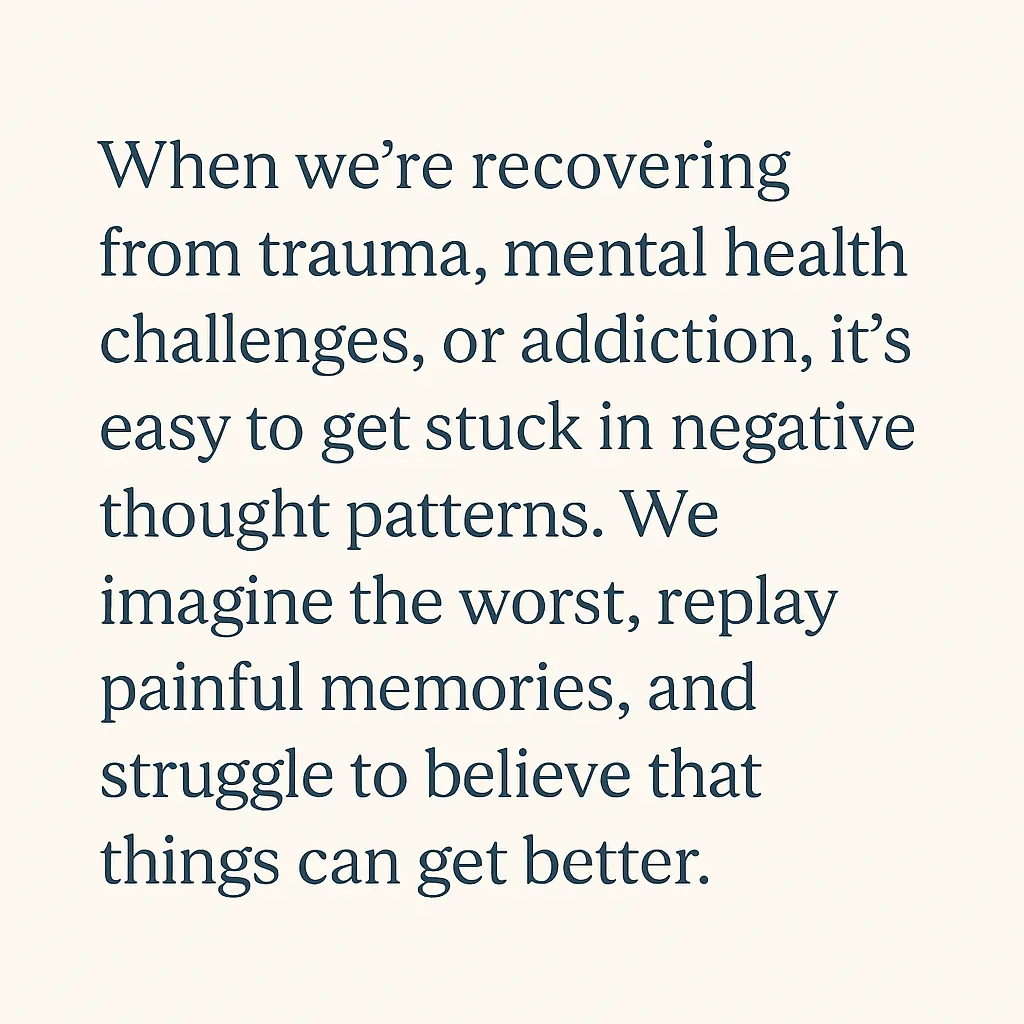Visualization Meditation: Rewiring the Brain for Hope and Healing

When we’re recovering from trauma, mental health challenges, or addiction, it’s easy to get stuck in negative thought patterns. We imagine the worst, replay painful memories, and struggle to believe that things can get better.
But what if we could train our minds to see a new future—one rooted in hope, peace, and healing?
That’s the power of visualization meditation. It’s a gentle yet transformative practice that allows us to create new mental images, shift our mindset, and begin to rewire the brain toward recovery and emotional growth.
What Is Visualization Meditation?
Visualization meditation is a technique where you intentionally create mental images to influence how you think and feel. Unlike traditional mindfulness (which focuses on observing the present), visualization invites you to imagine the future or access calming inner spaces.
These guided images could include:
* A peaceful garden or healing light
* Seeing yourself sober, confident, or free from pain
* Reconnecting with an inner child or future self
* Visualizing successful steps in your recovery journey
Visualization combines the power of imagination with the calming effects of meditation, making it both emotionally uplifting and neurologically powerful.
How Visualization Rewires the Brain
Our brains are incredibly adaptable. The more we think certain thoughts or picture certain outcomes, the stronger those neural pathways become. This is called neuroplasticity—the brain’s ability to change itself based on experience and repetition.
According to a study published in Trends in Cognitive Sciences, mental imagery activates the same brain areas as actual physical experiences (Pearson et al., 2015). This means that imagining a peaceful state or a healing scenario can have real, measurable effects on how we feel and behave.
Over time, visualization helps:
* Reduce anxiety and stress
* Replace negative thinking with empowering beliefs
* Support long-term behavior change
* Promote emotional resilience and hope
Why It’s Especially Helpful for Healing
🌱 1. Creates a Safe Inner Sanctuary
For people living with trauma or emotional pain, the body and mind can feel like unsafe places. Visualization offers a safe space within, where healing can begin.
Imagining a nurturing light, a protective guide, or a peaceful scene helps soothe the nervous system and fosters a sense of inner safety—something trauma survivors deeply need.
💭 2. Breaks Cycles of Rumination
Negative thinking loops—common in depression, anxiety, and addiction—keep us stuck. Visualization interrupts these loops by giving the brain something new to focus on.
A 2018 study in Behaviour Research and Therapy found that positive imagery training reduced symptoms of depression and increased positive affect and motivation (Blackwell et al., 2018).
🧠 3. Rebuilds Self-Belief
When you visualize yourself calm, sober, or confident—even for a few minutes a day—you begin to shift your identity. You stop seeing yourself as broken and start seeing yourself as someone who is capable, healing, and whole.
This shift in self-image is critical for lasting recovery.
Simple Visualization Meditation Practice
You don’t need to be an expert or have a vivid imagination to benefit. Even subtle images or feelings can have a big impact over time. Here’s a basic guided practice:
🌼 Guided Visualization: The Healing Light
1. Find a quiet space. Sit or lie down comfortably. Close your eyes and take 3 deep, slow breaths.
2. Imagine a warm light above your head. This light can be any color that feels comforting to you.
3. Visualize the light entering your body through the top of your head, slowly flowing into your chest, arms, and down into your legs.
4. As the light moves, imagine it soothing, healing, and softening any pain, tension, or negative emotion.
5. Repeat silently: “I am healing. I am safe. I am becoming whole.”
6. Stay with the image for 5–10 minutes. When you’re ready, gently open your eyes.
Tips for Building a Visualization Practice
* Start small: Even 2–5 minutes a day can help.
* Use audio guides: Apps like Insight Timer, Calm, and YouTube offer free visualizations.
* Combine with journaling: Write about the images or messages that came up after each session.
* Visualize at key moments: Before therapy, during a craving, or when feeling anxious.
Consistency builds new pathways. With time, visualization becomes more natural and more effective.
When Visualization Feels Difficult
Some people struggle to “see” images clearly in their minds—and that’s okay. Focus instead on the feeling of the image. For example, if you’re imagining walking through a forest, you might not see the trees, but you can feel the calm, hear the birds, or sense the sunlight.
Visualization is not about perfection—it’s about presence and intention.
Final Thoughts
Healing is not just about fixing what’s broken—it’s about creating what’s possible. Visualization meditation invites you to step into that possibility, to see yourself beyond the pain, and to believe in a future where peace and purpose are real.
With each session, you teach your brain—and your heart—that hope is not just a dream. It’s something you can grow, one image at a time.
Because the stories we imagine often become the lives we live.
Sources
* Pearson, J., Naselaris, T., Holmes, E. A., & Kosslyn, S. M. (2015). Mental imagery: Functional mechanisms and clinical applications. Trends in Cognitive Sciences, 19(10), 590–602.
* Blackwell, S. E., Browning, M., Mathews, A., Pictet, A., Welch, J., Davies, J., & Holmes, E. A. (2018). Positive imagery cognitive bias modification (CBM) and internet-based cognitive behavioural therapy (iCBT): A randomized controlled trial. Behaviour Research and Therapy, 104, 1–10.






